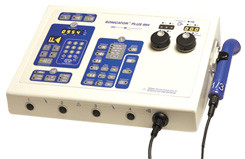 1st Jul 2015
1st Jul 2015
Ultrasound Therapy vs. Electrical Stimulation
Technology has an important role in physical therapy. And with advancements in technology, it can be tough to keep up with all the healthcare trends and understand what treatments are available and appropriate. One of the main goals of any physical therapist is to enhance a patient’s function in a cost/time efficient manner and two of the modalities commonly used to achieve this are: ultrasound therapy and electrical stimulation.
Physical Therapy Modalities: Ultrasound vs. Electrical Stimulation
Most people have heard about ultrasound, but few understand the number of applications for its use. In physical therapy, ultrasound can be used to reduce edema, promote tissue and fracture healing, reduce pain and muscle spasms, increase range of motion, and remodel collagen.
How Ultrasound Therapy Works
Ultrasound Therapy uses high frequency sound waves to create tissue vibration which causes heat within the area of treatment. The physical therapist will use a coupling medium (gel or water) to transmit the sound waves to the treatment area. As a result, the heat created increases blood flow which delivers important nutrients to the cells and removes waste from the tissues.
Mettler Sonicator 740x Ultrasound Therapy Machine
How Electrical Stimulation Works
Electrical stimulation (E-stim) uses the strategic placement of electrodes to apply electrical current to specific muscles. E-stim can be used for neuro-muscular reeducation, decreasing pain and edema, decreasing atrophy and muscle spasms while increasing range of motion.
In most treatment plans, physical therapists use combined modalities to maximize results. There are two specific results which can be attained through the use of ultrasound therapy and/or electrical stimulation: managing contractures/increasing range of motion and managing pain.
Combination Therapy Machines are Available to Perform both Ultrasound
and EMS Therapy
Contracture Management
Contracture or the shortening of muscles, tendons and ligaments can limit a patient’s range of motion. Ultrasound therapy applies deep heat to the muscles with limited range of motion and helps stimulate the Golgi Tendon Organs which activates the Protective Relaxation Reflex, which is a fancy way of saying it allows the muscle to lengthen and relax. E-stim is used to reeducate muscles or perform a nerve block to decrease pain. These therapies are usually used with orthotics which give patient’s a gradual/prolonged stretch over a longer period of time. It’s important to educate the patient with necessary range of motion programs/exercises and a splinting schedule so they understand that they must take an active role outside of their session in order to maximize results.
Pain Management
In managing pain, ultrasound therapy increases circulation and blood flow to the effective area which aids in decreasing pain as well as edema and muscle tightness. Electrical stimulation completes a nerve block which reeducates the pain receptors. It’s extremely important to be aware of any medication a patient is taking when using e-stim. Some medications may actually decrease the effectiveness of e-stim. As such, the timing of treatment will need to be adjusted to when the pain medication is least present in the patient’s system.
Physical therapists are focused on patient’s function and the ability to heal patients as quickly and cost-effectively as possible. While ultrasound therapy and electrical stimulation are not applicable for all treatments, their effectiveness in helping manage pain and increase range of motion make them powerful tools for a physical therapist to achieve that.
For more information about Physical Therapy devices See our Blog at ProHealthcareProducts.com







